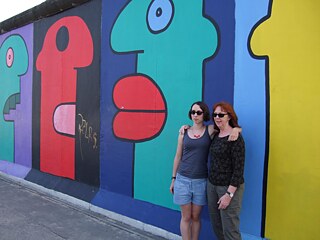Bicultural Urbanite Brianna
Commemorations begin 30 years after the Wall's fall

This month marks the 30th anniversary of the fall of the Berlin Wall. While celebrations a decade ago were muted, this time around the German capital plans on pulling out all the stops. But, it seems like not everyone has moved on from a separated Germany.
By Brianna Summers
Ten years ago, I commemorated the 20th anniversary of the Mauerfall by standing in the rain on Berlin’s Schillingbrücke bridge. I was part of a shambolic flash mob attempting to form a candlelit human chain along the route where the Berlin Wall once stood. It was a miserable rainy night, so the turnout was low. Our “chain” was full of holes and we had to keep relighting the sodden wicks of our candles.
Not far away, official celebrations were taking place at the Brandenburg Gate. Three dozen international dignitaries sat in a temporary structure wrapped in transparent plastic, including representatives from the four allied powers that had carved up post-Nazi Germany. Behind them stood a sea of raincoats and umbrellas and a row of 1,000 enormous dominos marking out where the Berlin Wall had sliced through the heart of the city. Weighing 20 kg each, these colourful dominos were symbolically knocked over at the culmination of the festivities.

7 DAYS, 7 LOCATIONS, OVER 100 EVENTS
That was then. In 2019, Berlin has pulled out all the stops. Commemorative events will be held over seven days at seven key sites of the peaceful revolution, including Prenzlauer Berg’s Gethsemane Church, Kürfurstendamm, Alexanderplatz and the former Stasi headquarters in Lichtenberg. The budget is a cool €10 million—twice that of the 2009 domino extravaganza. 30 years on, punters will once again be encouraged to reflect upon that life-changing night in November, when David Hasselhoff sang “I’ve been looking for freedom” (and narrowly avoided being sconed by a fire cracker). But that’s not all. Over 100 events will delve into the division of the Cold War, the revolution and the subsequent Reunification process. It’s a broad approach involving lectures, exhibitions, concerts, film screenings, theatre productions, workshops, panel discussions with contemporary witnesses and even an augmented reality app.It remains to be seen whether these events will reinforce the dominant narrative of Reunification, or critically unpack the past and provide space for fresh contemplation about what has happened since 1989. After all, the knock-on effects of the 28-year division are still being felt—culturally, psychologically and financially. German taxpayers still the pay “solidarity surcharge” that was established to finance the costs of Reunification. Income disparity still looms large.
According to Tagespiegel, the median net wealth per household in Germany’s new states (former East) is €23,400 and this figure is about four times higher in the old states (former West). Similarly, employees in the new states are still paid 17% less on average than their western counterparts and unemployment the former GDR is also comparatively worse, although both these trends are improving.

THE WALL INSIDE PEOPLE’S HEADS
Many former East Germans still feel the process of Reunification could have been managed more equitably and most Germans across the board still don’t feel the country is truly unified. In a survey published this month by Tagesschau, nearly half of the Wessie respondents felt that Reunification was "generally fair", while the Ossies were less sure, with one third stating "generally fair" and another third stating "generally unfair". When asked whether they think Germany has "grown closer", a clear majority on both sides didn’t particularly agree with the statement.Despite the complexity involved in commemorating such a pivotal historical event and its aftermath, organisers have also not forgotten the simple power of public spectacle. Open-air exhibitions involving 3D video projections and sound installations will be complemented by a massive art installation called "Your vision in the skies above Berlin". Countless 140-character messages submitted by the public about Reunification will be fashioned into an enormous flag, in a nod to the banners used at the peaceful protests that took place throughout the GDR between 1989 and 1991. And according to Berlin.de, the week will culminate with a multimedia stage show at the Brandenburg Gate featuring acts such as a “real-time technology dance performance”, followed by after-parties in 27 Berlin clubs and 27 clubs throughout Europe.
From panel discussions to pyrotechnics, it looks like the weeklong celebrations will have something for everyone—regardless of whether you’re a Wessie, an Ossie or an Aussie.